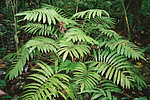Danaea nodosa
Maarten ChristenhuszIntroduction
Danaea nodosa is the type species of the genus Danaea. It occurs in the Greater Antilles and Southern Brazil, but the name has been widely applied to similar species in the "Danaea"-clade, like D. media in Central America, D. kalevala in the Lesser Antilles, and D. nigrescens in Amazonian South America.
In the Greater Antilles D. nodosa grows in clayey patches between karsted limestone rocks in closed canopy forest, commonly at low elevations. At the higher elevations of Hispaniola and Puerto Rico, the species is replaced by D. grandifolia.
Characteristics
Danaea nodosa has a dorsiventrally creeping rhizome with only two rows of fronds. The fronds grow up to 180 cm tall, and despite its name, lack nodes on the stipe. The pinnae are oblanceolate and finely serrulate at the apex.
Title Illustrations

| Scientific Name | Danaea nodosa (L.) Sm. |
|---|---|
| Location | Ecclesdown, Portland Parish, Jamaica |
| Specimen Condition | Live Specimen |
| Identified By | Maarten Christenhusz & Hanna Tuomisto |
| Life Cycle Stage | sporophyte |
| Copyright |
© Maarten Christenhusz

|
About This Page
Maarten Christenhusz

The Natural History Museum, London, United Kingdom
Correspondence regarding this page should be directed to Maarten Christenhusz at
Page copyright © 2009 Maarten Christenhusz
 Page: Tree of Life
Danaea nodosa.
Authored by
Maarten Christenhusz.
The TEXT of this page is licensed under the
Creative Commons Attribution-NonCommercial License - Version 3.0. Note that images and other media
featured on this page are each governed by their own license, and they may or may not be available
for reuse. Click on an image or a media link to access the media data window, which provides the
relevant licensing information. For the general terms and conditions of ToL material reuse and
redistribution, please see the Tree of Life Copyright
Policies.
Page: Tree of Life
Danaea nodosa.
Authored by
Maarten Christenhusz.
The TEXT of this page is licensed under the
Creative Commons Attribution-NonCommercial License - Version 3.0. Note that images and other media
featured on this page are each governed by their own license, and they may or may not be available
for reuse. Click on an image or a media link to access the media data window, which provides the
relevant licensing information. For the general terms and conditions of ToL material reuse and
redistribution, please see the Tree of Life Copyright
Policies.
- First online 23 January 2009
- Content changed 23 January 2009
Citing this page:
Christenhusz, Maarten. 2009. Danaea nodosa. Version 23 January 2009 (under construction). http://tolweb.org/Danaea_nodosa/56816/2009.01.23 in The Tree of Life Web Project, http://tolweb.org/








 Go to quick links
Go to quick search
Go to navigation for this section of the ToL site
Go to detailed links for the ToL site
Go to quick links
Go to quick search
Go to navigation for this section of the ToL site
Go to detailed links for the ToL site